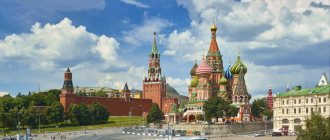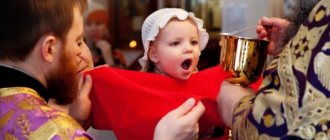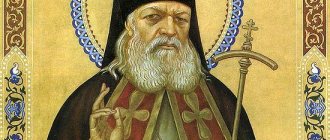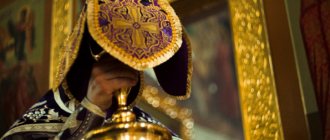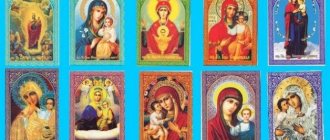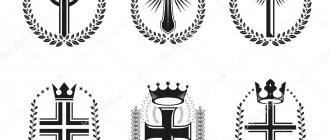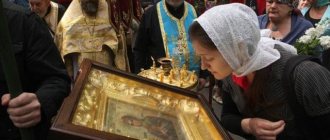History of icons
Church traditions say that the first icon was painted by the apostle and evangelist Luke. He depicted on the board from the dining table the image of the Blessed Virgin Mary with a baby in her arms. When the Mother of God saw the creation, she said that the grace of Her Son would always be with this icon. The physician and artist Luke is considered the first icon painter. With his light hand, holy images of the Mother of God, God's saints and martyrs began to be depicted everywhere. The main church holidays were also depicted on the icons. However, with the advent of the first paintings depicting saints, people still did not know how to venerate the icon correctly. Rules for the behavior of believers in front of holy images were established later.
Unlimited help from the saint
Orthodox believers tirelessly ask the merciful Matrona, who is the most glorious servant of the Lord, in a variety of circumstances, hoping to get what they want and find happiness. Parishioners read prayers for healing from a serious illness. Over the course of her entire life, the divine old woman brought to her feet more than a dozen unfortunate patients who had been suffering for a long time and could not find peace.
How to pray:
The blessed saint is able to restore the family by breathing the right thoughts into the consciousness of the husband or wife. In addition, Matrona can give childless couples a long-awaited child who will receive the same great love that she herself experienced.
If a person has a large family, and circumstances require a fair amount of funding, the holy oxbow is able to gift the person with work that will bring honest money.
Some people come to the relics or face of the saint to ask for admonition and strengthening of faith in the One God. Such individuals soon gain spiritual vision and begin to bring great benefit to their surroundings.
Icons and relics of the venerable saint are able to protect true believers from the influence of evil spirits, and also help to gain true trust in the works of the Lord, who always knows how to act more beneficially and fairly for his children.
Icon and relics of Saint Matrona of Moscow
Today there are several of the most popular ways that Orthodox believers use to ensure that their prayers reach the heart of the Venerable Matrona.
- Most people strive to visit the shrine with its relics and touch the divine list. The Pokrovsky Monastery, where the remains are located, is located in Moscow at st. Taganskaya No. 58. The church complex is open seven days a week and is open from early morning until the evening.
- She has colossal power. It is here that Matrona of Moscow was buried. The memory of this place was practically erased, but veneration resumed 30 years after the death of the blessed old woman, as she herself predicted. The relics were solemnly transferred to the Intercession Monastery, and a miraculous vessel with sand was installed at the site of the coffin, which also helps in difficult times.
- You can write a letter to the blessed mother, which should be sent to the address of the Intercession Monastery. This petition will be placed on the relics of Matrona.
- Often Orthodox believers turn to sacred icons depicting the venerable old woman. There is practically no church in Russia that does not have such a list. Most parishioners strive to touch the relics because they consider this gesture more direct and quick. However, one should not forget about the purity of thoughts, because the saint will refuse to fulfill evil requests that cause harm.
Iconography
Each icon is created in accordance with church canons. This means that the holy image on it must be recognizable and have a transcript of the image or church event. Currently, there are more than a dozen schools of iconography. Each master has his own signature style. Icon painters say that their work requires enormous dedication. After all, before the start of creation, during the painting of icons and at the end, certain prayers are read, that is, throughout the entire work of creating the holy image. Therefore, not only the creative approach is important here, but also the spirituality of the master.
Each icon must be consecrated. To do this, certain prayers are read over it, depending on the Saint depicted, and then the picture is sprinkled with holy water. Only after consecration the image becomes Holy.
Petitions for help from Saint Matronushka
Ordinary lay people do not have spiritual vision and make big mistakes, so they often need divine intervention. Saints, who are mediators between God's will and humanity, are able to correct troubles if people sincerely repent and ask for help.
Many Orthodox believe that Saint Matrona is capable of performing miracles
Matronushka is one of those who with great love fulfills the noble requests of honest people. Her life was an example of righteous worship, and after death the blessed saint does not tire
- Before turning to the venerable old woman, you should read a prayer to the Most High Lord, the Most Pure Virgin and Jesus Christ. The place of appeal is not particularly important: everyone can ask for help in their own home, temple or at the grave of Matrona. However, many pilgrims say that the most effective way is to turn to the remains located in the Intercession Monastery.
- In the same place where the shrine with the relics of the saint is located, there are also two of her sacred images, which crowds of religious people want to touch every day.
- Matrona had a special relationship with water; it was through it that Mother most often healed illnesses. Therefore, parishioners who visit venerate the holy spring, filling their bodies with the purest and most blessed substance.
- So that the saint can listen to prayers and intercede with the Almighty Father, Orthodox believers are obliged to open their hearts in conversation with her. One must discard useless thoughts about empty objects of the material world. One should focus on the purity of the request, which comes from a good intention.
- The reverend saint very quickly responds to prayers addressed to her. If your goals are not achieved the first time, you need to correct your own train of thought, not lose faith in the Lord, and continue to pray. Thus, the saint corrects inclinations towards a sinful worldview and teaches us to rely not only on ourselves.
- They often come to Matrona of Moscow with flowers and other gifts to express their gratitude. A person should not only ask for help, but also thank him for the fact that God’s great servant bestows bliss, because only by turning to the saint does a simple layman find peace.
- Therefore, the aisle where the shrine with the remains of Matrona is located is always strewn with flower arrangements. The bouquets are blessed with the blessing of the church and distributed to parishioners, who take them home, dry them and place them on the home iconostasis. The saint was extremely fond of lilacs, chrysanthemums, tulips and roses.
Important!
There is no strict framework for addressing the holy saint; she is ready to listen to prayers at any time and under any circumstances. It is important to show respect for those around you and try to uproot from your own consciousness sinful inclinations that bring only suffering to the individual and those around him. It is recommended to give alms and provide assistance to anyone who really needs it. The holy saint knows how to listen to prayers and knows about our good deeds, which increase the chances of people’s requests being fulfilled.
Rules for applying to icons
When reading a prayer in front of an icon, Orthodox Christians believe that it will be heard by the Saint immortalized on it. And indeed it is.
How to venerate an icon correctly? First, you need to cross yourself twice, then lightly touch the edge of the icon with your lips, and then your forehead. Then move away and cross yourself again. Women must learn one rule: before approaching the icon, you need to remove the lipstick from your lips.
You should not kiss the holy image several times and along the entire perimeter of the glass. Under no circumstances should you kiss the face of a saint. If the icon is “waist-length,” you need to venerate the blessing hand. When painting a full-length painting, you should touch your feet. If a believer doubts where to kiss the icon, it is better to kiss its edge.
In the icon of the miraculous image of the Savior Jesus Christ, the image of His hair should be venerated. When venerating the cross, you need to venerate the Savior’s feet.
How to light candles
Candles are bought from the church shop directly inside the church. Purchased candles are not placed near icons outside the church walls. A candle is an integral attribute of worship. You cannot put her before the face of a saint with a “cold” heart - this is sinful. You need to light a candle, say a prayer, and you don’t have to know it by heart - you can do it in your own words. When turning to the Lord in prayer, you need to focus on your words.
There is no clear rule about how many candles should be lit and to whom. Priests recommend placing one first in front of the holiday icon, then - at the relics of the saint, and then - in the saints.
Is it possible to kiss
Many doubt whether it is possible to kiss icons in church. This is how the church answers this question. In everyday life, people express their love and trust with a kiss. It's the same with icons. When a believer kisses it, he thereby expresses reverence for the image depicted on it.
However, more and more often, people who are far from Orthodoxy are trying to teach others how to behave correctly in church, and are proving that icons cannot be kissed. As an argument, they describe the results of experiments in which fingerprints were taken from icons. Scientists discovered many dangerous bacteria in them, which remained after numerous applications to the icon. However, the priests convince that a believer should not be afraid of this. The Lord protects the parishioners. But as an alternative, it is proposed to simply place your forehead on the edge of the icon as a sign of veneration and reverence for the holy image.
How to venerate the relics of Matrona of Moscow?
Mother Matrona helps in all everyday matters. She is asked for intercession, healing and solutions to problems in personal life and business. Prayer to Matrona of Moscow for help helps to arrange your personal life, give birth to a child, or detect a loss. The humble prayer to the holy mother must be said sincerely and with attention. It begins with the words: “Oh, blessed mother Matrono...” The short prayer sounds like this: “Holy righteous old woman Matrono, pray to God for us!”
Before venerating the relics of Matrona of Moscow, we must first of all understand that this is how we show our reverence and respect to her incorruptible body, which testifies to her great spirituality and holiness. Reverence for shrines is an integral part of the culture of the Russian Orthodox people.
How to enter the church
People who regularly attend church know how parishioners behave in church. However, are their actions correct? Usually the clergy explain how to properly enter the church. So:
- Before crossing the threshold of the church, you need to cross yourself 3 times at its doors, accompanying the actions with bows from the waist.
- Men enter the temple without hats. Women are required to cover their heads.
- Parishioners buy candles and, if desired, order a prayer for health or peace.
- How to dress for church? Men must wear trousers and outerwear that does not expose their torso. For women, the main requirement is a skirt below the knee and also a closed top.
After these actions, believers approach the icons, light candles and listen to the prayers read during the liturgy.
How to bow to the ground according to the rules?
All prayers and chants, after which kneeling is performed, must be accompanied by making the sign of the cross. Carrying out actions at the same time is incorrect.
Important! The prostration must be made slowly, with inner prayer and concentration. They stand up straight, cross themselves, kneel down, putting their hands on the floor and touching their foreheads
Then they rise and, if necessary, repeat the bow. In this case, it is necessary to cry out with the prayer “Lord, have mercy” or another one addressed to the Mother of God, an Angel or saints
They stand up straight, cross themselves, kneel down, placing their hands on the floor and touching their foreheads. Then they rise and, if necessary, repeat the bow. In this case, it is necessary to cry out with the prayer “Lord, have mercy” or another, addressed to the Mother of God, an Angel or saints.
Prostrations after Communion
In the first centuries of modern times, great prostrations were not made before Holy Communion. Before accepting the Blood and Flesh of the Savior, Christians worshiped to the waist and applied the sign of the cross to themselves. This is still observed in Byzantine churches.
Now Orthodox believers bow before the Chalice, even if they do not participate in the Eucharist.
On the day of Communion of the Holy Mysteries of Christ, you cannot prostrate yourself. Bowing expresses a feeling of repentance, pain about one’s sins. The communicant must unite with the Lord during the process of the Sacrament and remain in spiritual reverence.
Bowing in the temple should be done slowly and in a timely manner
After Communion, you must offer prayers of thanksgiving to the Lord, which are read at the end of the service, or pray on your own at home.
Prostrations at the Liturgy
At the Divine Liturgy one must worship as follows:
- three bows to the waist while reading and singing the prayer “Holy God”, “Come, let us worship”, “Blessed be the name of the Lord from now on and forever”, after three times “Hallelujah”;
- three homages to Psalm 119;
- a small bow and the sign of the cross at the exclamations of the priest, while singing “Lord, have mercy”, “Give, Lord”;
- belt worship on prayers, stichera, only after the words “Let us fall down,” “Let us bow,” “We pray”;
- prostration at the first and second manifestation of the Holy Gifts;
- earthly worship after the words “We thank the Lord”, after the completion of the hymn “We sing to You”;
- a small bow is made before and after reading the Gospel;
- bow from the waist when reading the akathist, on kontakion and ikos.
Is it possible to bow to the ground from Easter to Trinity?
On the days from the Feast of the Resurrection of the Lord Jesus Christ to the Holy Trinity, great bows are prohibited. But when taking out the Chalice, kneeling down to give thanks to God is not forbidden.
Important! At home, you can kneel after reading kathismas and prayers. A Christian must strive to become familiar with church order, have spiritual education and an active faith
There is no need to make comments to parishioners, but rather go deeper into yourself and pray
A Christian must strive to become familiar with the church order, have spiritual education and an active faith. There is no need to make comments to parishioners, but rather go deeper into yourself and pray.
Which icons are approached first?
As soon as believers enter the main part of the temple, a lectern with an icon of the Saint whose feast day is celebrated appears before them. Next to the Holy Image there is a cross. In front of a high quadrangular table with a sloping top, you should cross yourself twice with a bow from the waist, and then venerate the icon and the cross itself.
Which icons should you approach first after the lectern? Here the choice depends on the wishes of the parishioner. For example, you can put a candle for health in front of him. It would not be a mistake if a believer approaches the image of a particular Saint with a request for health and lights a candle there. It is better to find out from the priest which saints help with what, and then approach a specific icon with prayer.
For example, in front of the icon “The Inexhaustible Chalice” they ask for deliverance from drunkenness. Prayer in front of the image of the Healer Panteleimon helps get rid of serious ailments.
You need to remember the dead in front of a special icon. This place is called eve. It is located on the left side of the temple and is a table of 40 candles. You are allowed to remember the dead when leaving the church. One candle is enough for this.
What do the remains of God’s saints look like and where are they kept?
The remains of God's saints after death may look different. Sometimes the body is preserved completely, along with the skin, but more often it is a skeleton without flesh. But pious people also reverently honor the preserved bones of saints or ashes - after all, many martyrs were burned, sawed up, or given to predators. Only the strongest bones remained from Ignatius the God-Bearer; the rest went to wild animals; the holy martyr Polycarp was executed with a sword and burned. Their few remains were more valuable to believers than gold.
They treat with reverent veneration not only the body of the saint, but also everything that came into contact with him during life or after death. Even in the first centuries, Christians used the belts and scarves of the Apostle Paul to treat and drive out demons. The belt of the Most Holy Theotokos evokes special reverence and awe among all believers.
Depending on size,
the honorable remains of saints are kept in caskets, crayfish, and reliquaries. The body or its parts are placed in a special metal or wooden coffin called a raka. It is often carved and decorated with precious stones. On memorable days, the reliquary can be taken to the temple so that believers can venerate the shrine.
Reliquary with the relics of St. Job of Pochaev in the cave church of Job of Pochaev of the Holy Dormition Pochaev Lavra
The most common container for relics is a reliquary made of precious metals. It can contain particles of the relics of several saints at once. In addition to relics, other shrines are often placed in it - pieces of vestments or tombs, instruments of death. On special holidays, a religious procession is performed with him.
The relics are also placed in reliquaries; they come in different shapes. They can often be seen in icons of saints, in pectoral crosses. One of the most famous relics is the Kiy Cross, which contains more than 100 pieces of relics of saints. You can venerate him in the Church of Sergius of Radonezh in Moscow.
Relics that have never been opened are kept in sealed crayfish, i.e. "under cover." Among them are the relics of Anthony of Pechersk, Nikon of Radonezh, Joseph of Volokolamsk and many others.
How to properly venerate a shrine
One must venerate the relics of a saint, as with any shrine, first of all, consciously and reverently, with prayer and faith. If you know about worship in advance, you can especially prepare - read the life, akathist, learn a prayer in order to receive greater grace from the relics and not sin in the queue with condemnation and impatience.
When approaching the shrine, you need to cross yourself and bow twice, after kissing the reliquary, cross yourself and bow again. Girls should remember that there should be no lipstick on their lips. After moving away from the shrine, try not to lose the grace you have received for as long as possible. Do not demand a miracle this very minute, but earn it through your exploits. It is given to us according to our faith, which is why many apply, but only a few receive what they ask for.
Rules of conduct during worship
How to behave correctly in church? During the service, believers must stand quietly and listen to the prayer or read it together with the priest. You cannot walk around the temple, walk between the royal doors and the lectern.
How do newcomers behave in church when the service has already begun? If a believer enters a church during a service, it is better to take part in it and then light candles for the Saints. Let’s say that a parishioner does not have such an opportunity, which means that he must move around the church very carefully so as not to distract others from prayer. At the end of the service, believers leave the temple, crossing themselves 3 times with a bow from the waist.
How to properly leave church
When leaving the temple, you should cross yourself in front of the main entrance to the church, and also, additionally, when going beyond the common fence, if there is one. Here again, external actions are of secondary importance. The main thing is the thoughts with which you left the temple.
The main thing is the thoughts with which you left the temple
You must try to take out of the church, and try to retain for some time, all the bliss that you received during your stay there. And this must definitely happen, or at least. this is something worth striving for.
A person must enter the temple alone, and leave it completely different: renewed, having received the key to the door behind which the truth is hidden. This is especially true at the moment of communion. If you have gone through the procedure of accepting church sacraments and have not felt any changes, then in this case it is worth thinking about the reason.
A person should enter the temple one way and leave it completely different.
On the way home, you should remember what was sung at the liturgy and think about the meaning of what was said, also remember what the priest said during the sermon and try to keep all this in your thoughts for as long as possible.
And the last thing that is important to say, especially if you are a beginner and are going to visit the temple for the first time: never pay attention, and, moreover, this should not lead you into confusion, to the instructions that many parishioners of advanced age love to give out.
On the way home you should remember what was sung at the liturgy
This refers to instructions on how to light candles, make the sign of the cross, etc. But here it is important to make a reservation and say: if these teachings are of a friendly, calm nature and, most importantly, do not offend you in any way, then there is nothing wrong with that. On the contrary, any pious old woman with a kind heart can tell you a lot and teach you something.
We are talking about aggressive people. Such people should be nipped in the bud and nothing should be feared. Of course, this must be done calmly, without shouting or swearing, but at the same time strictly.
It is very important to distinguish the primary and main things from the less important, moments that in most cases do not change anything. The most important thing you need to take with you to church is a warm heart and sincere faith. All other knowledge and skills will definitely be applied.
What clothes to choose for the temple
Previously, men came to services in formal suits, and women in long dresses. Now, more and more often, parishioners come to the House of God in informal clothing, for example, men allow themselves to wear shorts, and women wear short skirts and trousers.
Modern youth believes that the main thing is not appearance, but what is inside a person.
How to dress for church? How does God want us to be in his home? The first pages of the Bible say that clothing should cover a person's nakedness. The Holy Scriptures teach people to dress godly. If parishioners come to the service in open clothes, they thereby show their disrespect for the shrine. It distracts from prayer. People just start looking at each other's bodies. Provocative and bright things are also unacceptable for the church, as they distract parishioners from worship. Clive Lewis wrote that fashion diverts a person's attention from true values. Even these words are enough to understand that you need to dress modestly in church. Congregants' bodies should be covered, and women should avoid wearing trousers during the service.
General rules
Appearance is important to everyone. Church service obliges a person to look neat and dignified, without leading anyone into seduction and temptation. You must come to church in clothes that are considered appropriate for the person’s gender: men in trousers, women in skirts.
How should a woman dress in church?
Unacceptable for the church:
- swimsuit;
- sportswear;
- clothes that are too revealing, bright and shiny for going to a disco or other provocative things.
Immodest clothing causes condemnation and temptation from others. A person comes to the temple to communicate and worship the Lord, and not for a fashion show. Strict clothing obliges a person to conduct himself with dignity and respect.
There is no need to pour a bottle of perfume on yourself during the service - the room is usually stuffy and someone may feel ill from the perfume. You need to give up cloying and pungent odors and limit yourself to taking a shower and applying deodorant.
Makeup should be invisible, and clothing with non-Christian symbols is also unacceptable.
Sign of the Cross
You need to be baptized slowly, together with everyone.
Making the sign of the cross is simple:
- connect the thumb, index and middle fingers of your right hand together;
- fold the remaining two and press them to the palm of your hand;
- with your right hand, successively touch your forehead, center of the abdomen, right and left shoulder.
The sign of the cross is made during the reading of the Gospel, blessing by the priest, glorification of the Trinity and Christ, proclamations, communion and veneration of icons, as well as during incense.
Sign of the Cross
For women
There are more rules for women in the temple:
- wear only skirts;
- cover your head;
- do not wear clothes that expose the lower back, are too tight to the body or reveal the shoulders;
- revealing cleavage is also unacceptable;
- there is no need to apply too flashy, revealing makeup - you can limit yourself to mascara and eyebrow pencil;
- no need to apply harsh perfume;
- during menstruation you should not approach the altar, it would be best to stay closer to the exit;
- stand on the left side of the building;
- after childbirth, you should also stand closer to the exit, and on the 40th day the priest performs a cleansing prayer over the woman.
When going to church, you need to realize why go there at all? Apply war paint and look for suitors or communicate and worship the Lord who sees the soul. Provocative clothing and makeup are a sign of immodesty.
Appearance of a woman in church
For men
For men, the rules are simpler, but they also exist:
- do not wear a hat in the church building - it must be removed before entering;
- have a neat and decent appearance;
- refuse sports or work clothes;
- to be shaved;
- refuse jeans, open T-shirts or transparent clothes (mesh T-shirts);
- do not smoke or drink before visiting the temple for 5-6 hours;
- It is best to wear a classic suit or trousers with a shirt;
- behave modestly and respectfully;
- stop on the right side of the building.
Attention! Men come up to communion first, women can come after them, and only then children. Their task is to treat the clergy with respect and respect, not to whisper or discuss the women around them
The rules for visiting a temple are important because it is not just a meeting of a community or commune, but a meeting of believers. People who do not attend services usually closely watch how Orthodox Christians go to church and how they behave during services.
We advise you to study Myrrh-streaming icons: why do icons cry?
However, the biggest problem remains the judgment of young people who come to church for the first time. Regardless of their appearance and behavior, you need to show leniency towards them and not speak rudely or lecture - gently correct them and help with advice, this will be right.
https://youtube.com/watch?v=BI7thicVyt4
How to behave correctly in an Orthodox church
Icons in the house
Even in ancient times, people had a tradition of bringing icons into their homes, usually two - the image of the Most Holy Theotokos and Jesus Christ. They were often supplemented with icons of saints whose names were borne by the owners of the house.
In the modern world, this custom has been preserved. Priests recommend setting up a prayer corner at home. There you can place icons and a small lamp in front of them. It is not advisable to purchase many icons, because these are not paintings and each image will have to be prayed for. If a home icon has faded, it must be set on fire. The holy image to which one prays must always be clear. Therefore, you cannot pray to icons distorted by age.
How to venerate an icon at home correctly, and is it necessary to do so? Here the actions of the believer are similar to church rules. This is how we express respect for the Saint whose image is depicted. Therefore, after prayer you can kiss the icon. It is recommended to have icons in the house with holy images of the Most Holy Theotokos, Nicholas the Wonderworker, martyrs Guria, Samon and Aviv, prayer to which helps to find family well-being.
General rules of conduct in church
The church charter is a huge collection of rules to which clergy and Christians who visit the temple are subject. In the Orthodox world these dogmas are revered in a special way. For novice parishioners, there is even a Sunday school that teaches how to behave correctly as a churchgoer.
General rules of conduct in church
Appearance
Going to church is an important event for any Christian believer. The Temple of the Lord does not accept frivolity or a condescending attitude, and therefore, before going there, one must bring oneself into a form that complies with the regulations. For women and men, the rules are significantly different, but absolutely all parishioners must have a cross on their body, given to them at baptism. It is worth remembering that church is not a place for entertainment or dating, and therefore you need to look modest.
Rules for women
According to church canons, women are allowed to enter the temple only with their heads covered and in long skirts or dresses. During services they occupy the left side of the parish, and during monthly allocations they stand closer to the door, not approaching the altar. The same rule applies to those who have recently given birth. They are allowed to attend church only on the 40th day after giving birth, when the priest will read a cleansing prayer over them. Orthodox dogma prohibits women from:
- wear clothes that are too short or tight;
- wear revealing dresses that excessively expose the body (including a deep neckline);
- do bright, provocative makeup;
- use strong perfume.
Rules for men
The church is more lenient towards the stronger sex, but there are also restrictions for men:
- Before entering the temple, you must remove your headdress;
- clothing must be neat and clean;
- It is not allowed to wear a robe or tracksuit;
- the face should be thoroughly shaved;
- several hours before attending church you should not drink alcohol or smoke.
Men tend to occupy the right side of the ward. Similarly to women, they must behave respectfully, modestly, not talk loudly, and not disturb other parishioners.
Bows and sign of the cross
In front of the main gate of the temple, it is customary to make the sign of the cross followed by bowing the head. The same is done inside the church if there is a service. All actions are performed by parishioners synchronously at certain moments of the service:
- while singing the glory of Jesus Christ or the Holy Trinity;
- when proclaiming the phrases: “Lord, have mercy” and “Give, Lord”;
- at the end of the ceremony.
Rules for making the sign of the cross
When starting a prayer, finishing it, lighting a candle or approaching holy images, it is also necessary to cross yourself and bow. In this case, the action is performed slowly, thoughtfully, following certain rules:
- cross themselves with their right hand;
- the hand is folded into three fingers, connecting the first three fingers together;
- movements are made from right to left;
- first they touch the forehead, then the navel, and end with the right and left shoulders;
- Having completed the sign of the cross, they bow from the waist.
You need to bow only after the hand has completely lowered, so as not to break the cross being created on the body. Author's advice
Appeals to priests and laity
It is customary to behave quietly in church, but sometimes there is a need to communicate with other parishioners or the priest. This can be done in a low voice, maintaining a respectful intonation. If someone else's shortcoming is noticed, you cannot ridicule or humiliate the person. You should approach him and delicately point out the error.
Temple servants are addressed according to their rank. During the greeting, the church charter does not allow a handshake from the side, but you can bow your head and put your lips to the right hand of the holy father. It is also strictly forbidden to interrupt the priest from worship or prayer. You should wait until the end of the ceremony and then make your request.
Why do Orthodox Christians venerate the relics of God's saints?
The tradition of venerating the relics of holy saints is based on the miracle of the Incarnation. The Christian Church believes that Jesus Christ was resurrected not only spiritually, but also physically, therefore the physical shell of a person has no less value than the soul. People who achieved unity with the Lord during their lifetime became the receptacle of His Grace, which they poured out into the world around them. This ability is possessed not only by a living body, but also by the remains of a holy person.
Holy relics are the greatest shrines of the Orthodox Church
The veneration of holy relics was officially established on II. At the same time, the priests emphasized the importance of understanding the fact that worship is performed neither to the remains nor to the person, but to the Divine Power contained in them.
